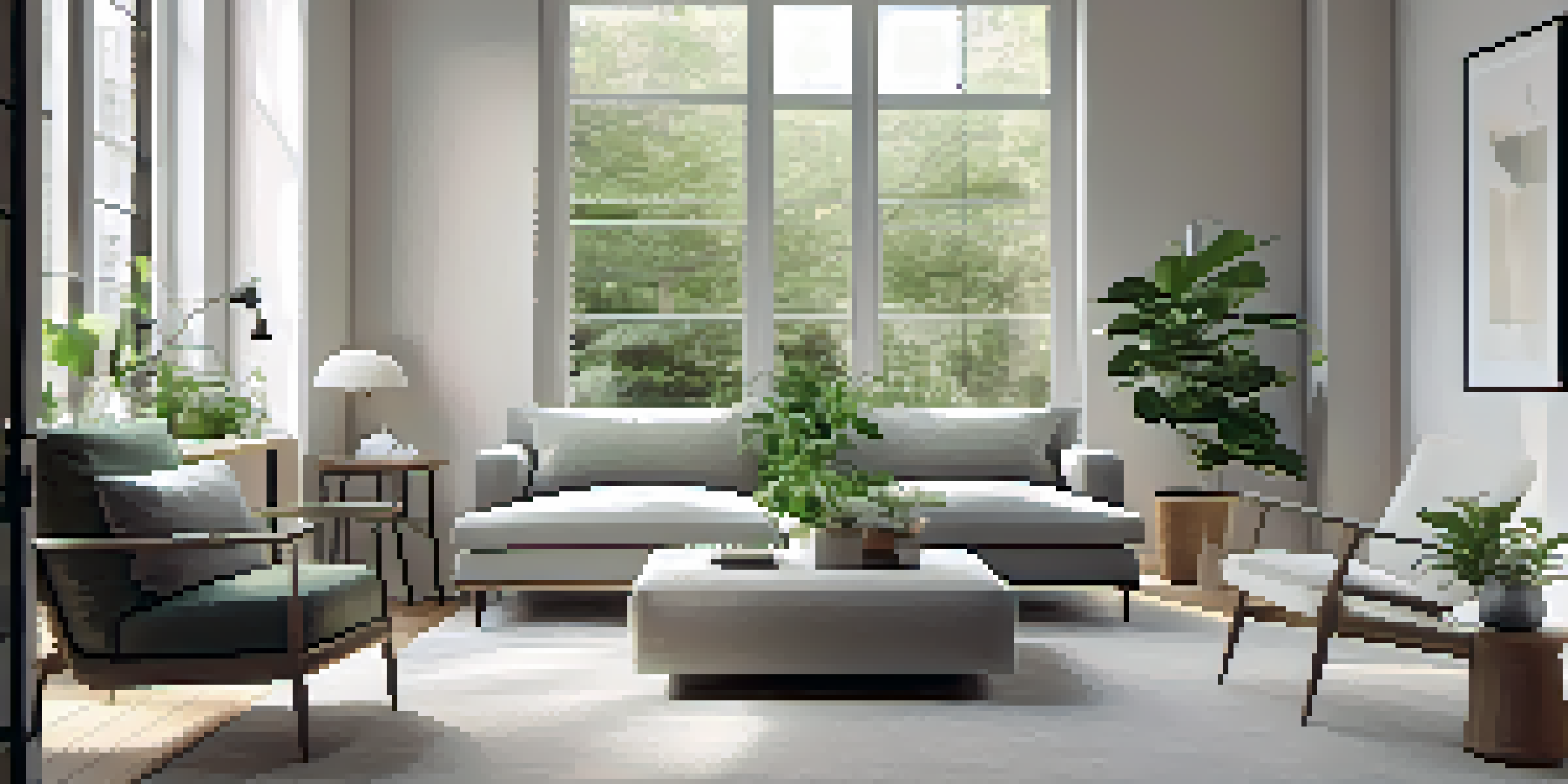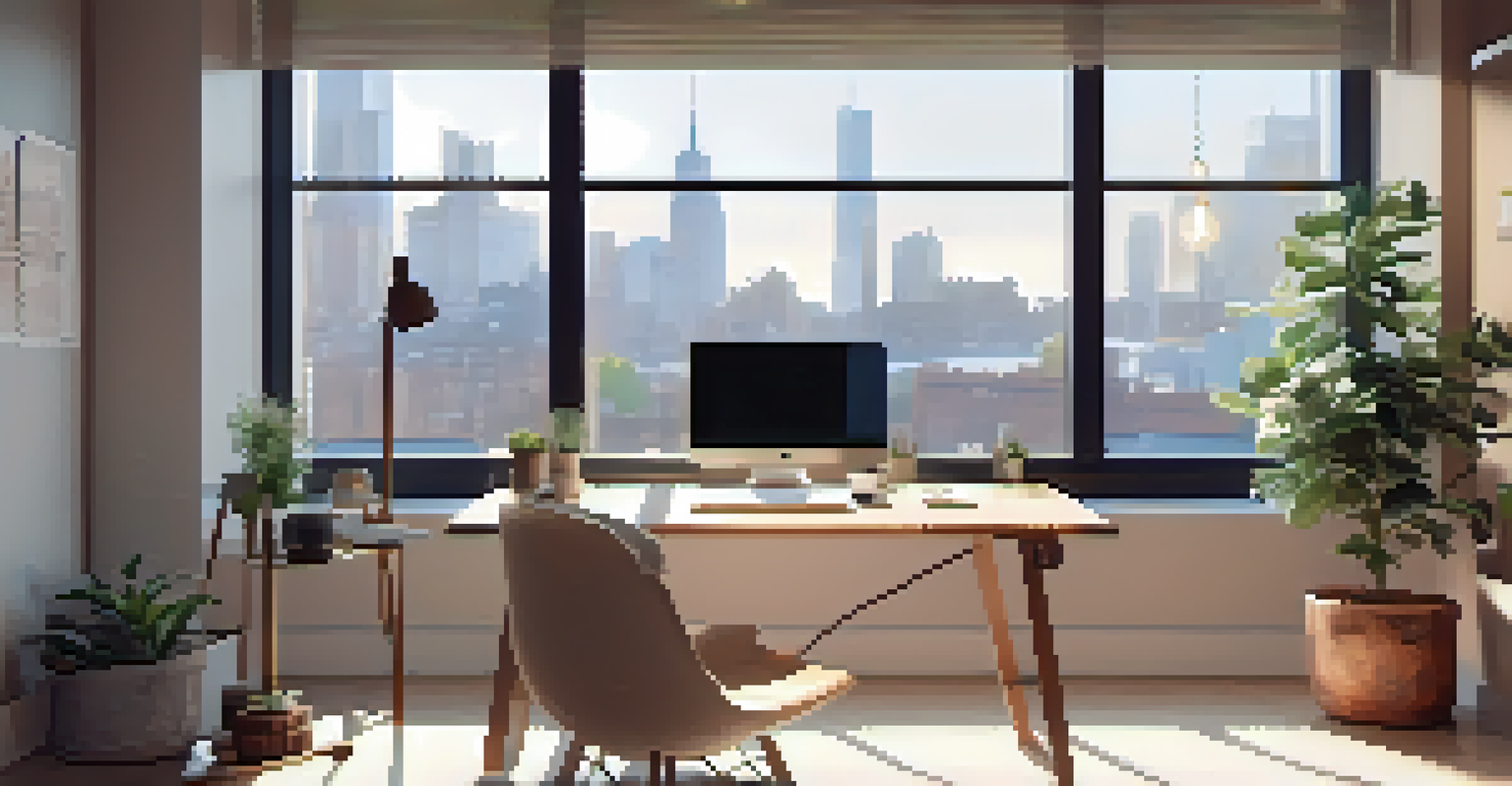Urban Living: The Shift Towards Minimalism

Understanding Minimalism in Urban Settings
Minimalism is more than just a style; it's a lifestyle choice that emphasizes simplicity and intentional living. In urban environments, where space is often limited, adopting minimalist principles can lead to a more organized and peaceful life. This approach encourages individuals to declutter not only their physical spaces but also their minds, promoting mental clarity amidst the hustle and bustle of city life.
The ability to simplify means to eliminate the unnecessary so that the necessary may speak.
Cities today are experiencing rapid growth, leading to crowded living conditions and overwhelming commutes. In response, many urban dwellers are gravitating towards minimalism as a way to reclaim their space and time. By prioritizing quality over quantity, individuals find that they can create a home that reflects their values and aspirations without the distractions of excess.
The idea of minimalism resonates with many people who seek to escape the consumerism that often accompanies urban living. By focusing on what truly matters—relationships, experiences, and personal well-being—individuals can foster a sense of fulfillment that transcends material possessions.
Benefits of Minimalism in Urban Living
One of the primary benefits of minimalism is the reduced stress that comes from living in a simplified space. When unnecessary items are removed, it creates a calming atmosphere that allows for better focus and productivity. For city dwellers juggling work, social lives, and personal responsibilities, this newfound serenity is invaluable.

Moreover, minimalism often leads to financial benefits. By purchasing fewer items and investing in high-quality essentials, people can save money in the long run. This frugal approach aligns perfectly with the urban lifestyle, where the cost of living can be quite high, allowing individuals to allocate their resources more wisely.
Another significant advantage is the freedom that comes from owning less. As urban residents embrace a minimalist lifestyle, they find themselves more adaptable and open to new experiences. This flexibility enables them to explore their cities more fully, whether it’s trying new restaurants or participating in local events, enriching their lives in ways that material goods cannot.
Practical Steps to Embrace Minimalism
Starting your minimalist journey doesn’t have to be overwhelming. A good first step is to conduct a thorough decluttering session. Go through your belongings and ask yourself which items truly add value to your life and which ones can be let go. This process not only clears physical space but also provides a sense of accomplishment and clarity.
Simplicity is the ultimate sophistication.
Next, consider implementing the 'one in, one out' rule. For every new item you bring into your home, challenge yourself to remove an existing one. This practice encourages mindful consumption and prevents clutter from accumulating again. It’s a simple yet effective way to maintain balance in a busy urban lifestyle.
Lastly, create a minimalist mindset by focusing on experiences over possessions. Instead of investing in the latest gadgets or trendy decor, consider spending on adventures, such as traveling or taking classes. These experiences can provide lasting joy and memories that far outweigh the fleeting satisfaction of material items.
The Role of Technology in Minimalism
Technology plays a pivotal role in supporting a minimalist lifestyle, particularly in urban settings. With the rise of smart home devices, individuals can manage their spaces more efficiently, reducing clutter and streamlining daily tasks. This tech-savvy approach enhances convenience without adding to physical possessions.
Additionally, digital decluttering has become an essential part of minimalism. Just as we clean out our closets, it's important to manage our digital spaces by organizing files and unsubscribing from unnecessary emails. A clutter-free digital environment can lead to improved focus and productivity—key factors for thriving in a fast-paced urban lifestyle.
Moreover, various apps and tools are available to help individuals track their spending and habits, promoting mindful consumption. By utilizing technology wisely, urban dwellers can reinforce their commitment to minimalism, ensuring their homes and lives remain simple and intentional.
Minimalism and Sustainable Living
Minimalism and sustainability go hand in hand, especially in urban environments where resources can be limited. By choosing to own fewer items, individuals reduce their carbon footprint and lessen the demand for mass production. This not only benefits the environment but also encourages more thoughtful purchasing decisions.
Incorporating sustainable practices into a minimalist lifestyle can take various forms, such as opting for second-hand goods or supporting local artisans. These choices not only help preserve the planet but also foster a sense of community within urban settings. By connecting with local businesses, individuals contribute to a more sustainable economy.
Furthermore, minimalism often leads to a greater appreciation for nature. By focusing on experiences and quality, individuals are more likely to seek outdoor activities and engage with their surroundings. This connection to nature is essential for mental well-being, especially in bustling cities where green spaces can be scarce.
Challenges of Adopting Minimalism in the City
While the shift towards minimalism in urban living offers many benefits, it's not without its challenges. One significant hurdle is the pressure to keep up with consumer trends and societal expectations. Urban environments are often filled with advertisements and social media influences that promote a lifestyle centered around accumulation, making it difficult to resist the urge to acquire more.
Additionally, the fast-paced nature of city life can make it hard to slow down and evaluate personal belongings and habits. Many residents find themselves caught in a cycle of busyness, leaving little time for reflection or decluttering. This can lead to feelings of overwhelm, making the idea of minimalism seem unattainable.
Finally, emotional attachments to possessions can complicate the minimalist journey. Many people hold sentimental value in items that may no longer serve a purpose in their lives. Overcoming these emotional ties requires patience and practice, as individuals learn to prioritize experiences and relationships over material possessions.
The Future of Urban Minimalism
As more people recognize the benefits of minimalism, the trend is likely to continue growing in urban areas. With increasing awareness about mental health and well-being, individuals are seeking ways to create spaces that promote peace and clarity. This shift will undoubtedly influence how developers and city planners approach housing and community design.
Moreover, the rise of remote work has opened up new possibilities for urban living, allowing individuals the freedom to choose how and where they live. This flexibility can lead to more deliberate choices around minimalism and sustainability, fostering a culture that values quality of life over material accumulation.

In essence, the future of urban minimalism looks promising. As communities embrace this lifestyle, we may witness a shift towards more sustainable living practices, improved mental health outcomes, and a deeper appreciation for our surroundings. Minimalism is more than a trend; it's a movement that has the potential to reshape the urban landscape for the better.